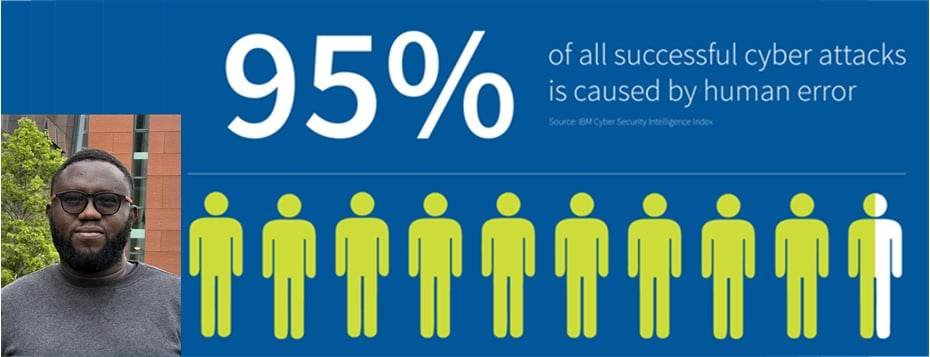It would be noted that BENEDICT JOSEPH OLUWASEUN, B.Sc., MBA, M.Ed, M.Sc. Information Security & Digital Forensic CISA, CISM, CRISC, CEH, PMP, ISO 27001 LA, PMP, would shed light on the topic of discussion and help employers understand the role of employees in thriving businesses.
“Human Error” has steadily been identified as a key contributor to cybersecurity breaches for several years. Recent cyber-attacks such as the Equifax breach, Uber, and the Capitol One Oil and Gas breach, which saw a ransom payment of 75 bitcoin ($4.4 million worth), could have been avoided if the employees had been equipped with the required skills and knowledge to identify and mitigate an attack. In other words, 19 out of 20 cyber breaches may not have occurred if human error had been eliminated!
Stanford University says employee error accounts for about 88% of data breaches. Even more unexpectedly, a study by IBM found that 95% of cybersecurity breaches were caused by human error.
Although firewalls and other technologies can be the foundation of a company’s cybersecurity program, they cannot guarantee complete protection. Numerous studies demonstrate that human error accounts for many reported breaches, and these typical human mistakes can harm cybersecurity:
Skill-based error: These are minor errors that occur while carrying out a daily task, often due to inattentiveness, tiredness, and distraction Lack of education and awareness: Employees may only know the risks or how to avoid them if they have received training in cybersecurity best practices.
Phishing: With more than 20% of breaches involving phishing, it is the most common threat action type.
Password management: Using weak passwords or storing them incorrectly can make it simple for hackers to access sensitive data.
Poor network management: Systems may become vulnerable to attack if network access and permissions are not correctly managed.
Decision-based errors are mistakes brought on by making bad decisions, like downloading malicious software or previous software updates.
Cybersecurity affects every sector worldwide, and companies must turn to their staff to augment traditional security solutions. In the past, the conventional firewall could stop hackers from coming in from the outside, but nowadays, hackers manipulate employees to circumvent traditional firewalls.
The way to fight back is to arm employees with knowledge and training and to work with them to build a resilient and knowledgeable human firewall. A human firewall is the real-world equivalent of a traditional network firewall.

To create human firewalls, human beings (employees) are given the tools to recognize and thwart cyber threats. The human firewall is built on continuous Security Awareness Training, giving everyone the knowledge to stop hackers.
- Develop a security culture with a “Security-First” mindset: Security is the concern of every employee (from the top – down) of the organization, and they should all be included in the security awareness training. Developing a robust security culture starts with the onboarding of employees.
Cybersecurity awareness training should be part of new employees’ hiring and onboarding processes. Organizations require employees who are both business-savvy and capable of defending their company against cyberattacks.
Employees are less likely to be motivated to learn about threats and how to avoid them if they aren’t aware of why it’s important. However, if they’re aware of a breach’s severe consequences, they’ll be more than willing to actively participate and adopt the security culture.
Talking openly about vulnerabilities and cybersecurity is another way to develop a strong security culture. Regularly distribute security updates, run phishing tests, engage staff in training, and emphasize team culture. Your human firewall will function better the more people who care, value, and enjoy what they do.
- Cybersecurity awareness training: A robust cybersecurity awareness training will provide adequate information to employees on how to recognize a cyber-attack, such as a phishing email campaign, and take the right actions to mitigate a breach.
The more training and education your employees receive, the more they know their role in protecting the business and the stronger the human firewall becomes.
Organizations and staff must stay current on the most recent risks and trends because threats and risks constantly change. Therefore, planning ongoing training sessions for your staff members is crucial rather than just a single event when organizing your security awareness training.
Security training should be engaging, scenario-based, and ongoing and should cover a variety of subjects, including phishing attacks, ransomware attacks, malware, and social engineering.
- Test your employees: After security awareness training, a test will allow you to determine whether or not your employees have retained the information. You can use testing to compare actual results with predicted ones and decide which areas and employees require improvement.
To accomplish this vital goal, using a security awareness training provider that provides simulated phishing tests will be beneficial.
In this manner, management can monitor how staff members behave. If workers fail these tests, they can receive additional training on how to recognize and respond to emails in the future.
- Incentives: Recognize and reward dedicated workers who have delivered excellent performance and have been active during and after training. In addition to salary, rewarding employees encourage them to stick with training, support a critical mission, and adopt a security culture.
Every employee desires to be a part of a developing and approachable workplace, so developing incentive-based programs will help employees feel they are contributing to the Human Firewall’s core values.
- Provide and use the right TOOLS: It will be easier to introduce security terms to your employees and make the training exercise more enjoyable if your company has and utilizes the appropriate set of tools for your security awareness training.
A platform that can simulate phishing attacks, binge-worthy video content, and gaming-style activities, give your team security awareness training, and provide compliance tools will motivate your employees to participate more.
Cybertalk.org claims that when you’re having fun, your brain is 68% busier. Designing a security awareness campaign that includes entertaining, engaging elements makes sense.
Other essential security tools for an organization include software, network security monitoring tools, encryption tools, antivirus data protection software, and vulnerability scanning tools.
The most effective way to deliver security awareness training that will stick to and encourage employee commitment to the program and become a part of the security-first culture is through an interactive, informative, and engaging training experience.
In conclusion, every business, regardless of size, must secure its organizations because cybercriminals will keep developing attacks against employees and organizations. One of the best ways to stay safe is to rely on your employees.
Although creating a successful human firewall can be a herculean task, starting with the above steps and enlisting the help of information security experts will help.
By carefully choosing, educating, and motivating your team members, you can assemble a security team ready to support and defend your company from cyberattacks.
A robust cybersecurity culture is essential for a successful human firewall, so keep that in mind.
Employees should be aware of the potential consequences of cyberattacks and how to take precautions. You can build a team of human firewalls and defend your organization from cyberattacks by enacting strict security policies and fostering a caring culture.

